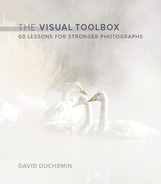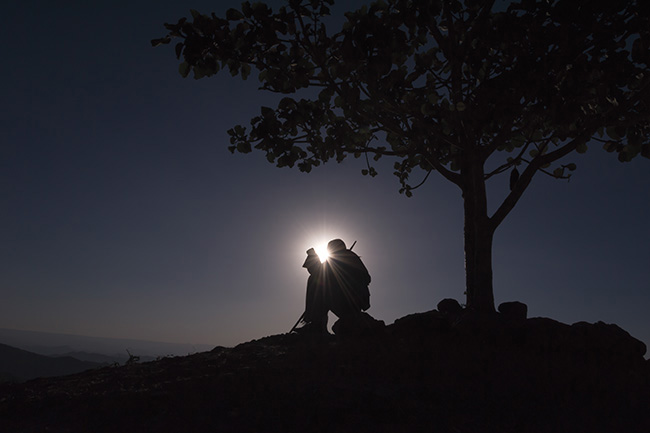Lesson 34. Light: Silhouettes
Silhouettes are an underused way to isolate, turning otherwise chaotic scenes and blown-out skies into pure shape, gesture, and light. When other attempts to work with a high-key scene fail because colors aren’t working well, or that one dude’s got a funny look on his face, or the sky isn’t doing it for you, try exposing for the sky and letting the rest of the frame go to shape and form. Whereas others are trying to eliminate the shadows with HDR techniques, try taking advantage of them. Silhouettes simplify and abstract. They turn individuals, recognized by their features, into anyone. They turn buildings into nothing more than their iconic outlines.
Nikon D3s, 22mm, 1/2500 @ f/18, ISO 200
A pilgrim is silhouetted against the setting sun in Lalibela, Ethiopia.
Making silhouettes is nothing more than exposing for your sky. If you’re shooting RAW you’ll still want to keep the histogram over to the right, but for this to work you need a high-key scene anyway, one where the dynamic range of the scene is close to, or more than, what your camera can handle. Set the spot meter to read the values in the sky, and use that as a starting point. You can always darken the shadows further in Lightroom later. Compositionally, remember that not all silhouettes are equally powerful. Look for the shapes, not the details. We’re so used to looking for smiles and the light in a person’s eyes, but in silhouette these things all but disappear, so look for the best possible outline: strong gestures, the climax of an action, recognizable profiles.

Nikon D3s, 16mm, 1/8000 @ f/6.3, ISO 800
Maasai warriors dance, silhouetted to focus on their form, simplifying what would otherwise be a washed-out and cluttered scene.
While shooting in Kenya last year I visited the village of a friend to introduce some students of mine to the villagers and make photographs while they danced under the hot mid-afternoon sun. We were in a tight village, surrounded by huts. Colors were contrasty, faces were in and out of shadow, and the whole scene was very chaotic. The Maasai dance involves a lot of jumping and vertical movement, and I knew I could exaggerate that by getting really low, so I lay down in the dirt and shot up. I chose a wide lens to capture the action and exaggerate the verticality of the dance. And I cranked the exposure down, shooting toward the sun.
Using silhouette, even as an occasional exercise, is beneficial because it helps us see. For some reason there’s greater visual mass in the details of things than there is in the shape of them, probably a lot like how we’d rather look at what’s in the frame of the photograph than the frame itself. But with a silhouette in the photograph, that shape is there whether or not we like it. As a line in the frame, the more we perceive, the greater our ability to control it and make stronger images.
“Look for the best possible outline: strong gestures, the climax of an action, recognizable profiles.”

